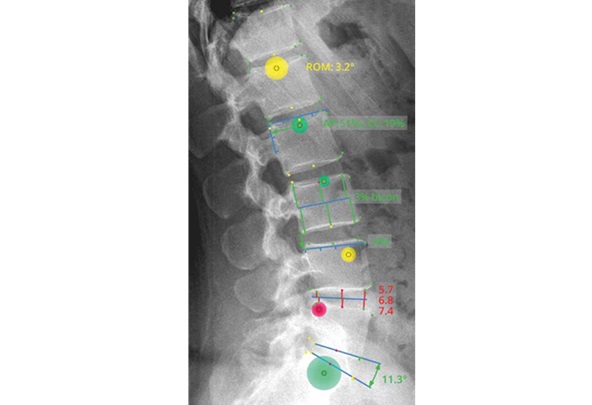IRVINE, Calif., Aug. 6, 2024 /PRNewswire/ — Aspen Medical Products (Aspen), the industry leader in spine solutions for pain and mobility management, has launched the Align Orthosis. In collaboration with spine surgeon Han Jo Kim, MD of the Hospital for Special Surgery, the all-new Align Orthosis is the first prefabricated TLSO designed to help mitigate post-surgical incidence of proximal junctional kyphosis (PJK).
“Isolation of a single strategy is yet to be successful in PJK prevention. When used post-operatively, the Align Orthosis is a non-invasive addition to mitigation strategies, so we truly have a multifactorial approach to prevention,” said Dr. Kim.
According to a published study in Spine1, spine deformity surgeries are increasing at a rapid rate, up 141 percent between 2004 and 2014. Additional research2 suggests that proximal junctional kyphosis (PJK) occurs in approximately up to 30 percent of adult deformity surgery patients, with most cases occurring within two years of surgery. Symptoms include pain, neurologic deficit and ambulatory difficulties – which can often lead to revision surgeries that are costly and painful. The lack of a singular solution for surgeons to mitigate the incidence of PJK underscores the need for a multifactorial strategy.
Dr. Kim recognized this issue and sought to find a solution. “Some of my patients had altered body mechanics, so I thought that using a brace for flexion control would be helpful in teaching them a better way to move their spine after an operation and ultimately reduce risk of developing PJK,” said Dr. Kim. This led to a retrospective analysis, comparing outcomes of a cohort of patients that were either braced or non-braced post-surgery. This research showed that post-surgical bracing with a hyperextension brace made a patient three times less likely to develop PJK.3
Despite the positive outcomes of the study, post-operative compliance varied due to flexion control problems and discomfort, such as the brace riding up when patients sat down and irritation at the surgical site. “We thought we could make improvements to the design to make it more patient-friendly, therefore increasing compliance and potentially mitigating the risk for developing PJK,” said Dr. Kim.
The Align Orthosis is an evolution of current hyperextension braces with better flexion control, comfort and patient compliance, helping to reduce readmission and revision surgery rates. This is achieved by a three-point pressure system that contacts key points at the chest, lower abdomen and mid-back. The design of the brace also helps to restore symmetrical spinal loads and guide patients through correct spinal biomechanics to help patients safely move after surgery and improve balance.
“The Align Orthosis embodies our commitment to advancing treatment and improving outcomes for spinal deformity patients, made possible through collaboration with spine surgeons,” said Jim Cloar, Aspen’s Chief Executive Officer. “As a leader in spinal care, we are dedicated to supporting surgeons with new strategies to help mitigate the increasing post-surgical PJK incidence rate.”
More information on the Align Orthosis is available at alignpjk.aspenmp.com.
About Aspen Medical Products
Founded in 1994, Aspen Medical Products, LLC is the industry leader in the development and manufacturing of spinal orthopedics and pain therapy solutions. Designed to restore function and alleviate pain, Aspen’s products address a variety of patient needs across the continuum of care to help them resume activities of daily living. Headquartered in Irvine, California, Aspen has local sales representation throughout the U.S. and internationally. www.aspenmp.com
- Beschloss, A., Dicindio, C., Lombardi, J., Varthi, A., Ozturk, A., Lehman, R., Lenke, L., & Saifi, C. (2021). Marked increase in spinal deformity surgery throughout the United States. Spine. Advance online publication. https://doi.org/10.1097/BRS.0000000000004041
- Kim, H. J., Lenke, L. G., Shaffrey, C. I., Van Alstyne, E. M., & Skelly, A. C. (2012). Proximal junctional kyphosis as a distinct form of adjacent segment pathology after spinal deformity surgery: A systematic review. Spine, 37(22 Suppl), S144–S164. https://doi.org/10.1097/BRS.0b013e31826d611b
- Shahi, P., Merrill, R. K., Pajak, A., Samuel, J. T., Akosman, I., Clohisy, J. C., Du, J., Zhang, B., Elysee, J., Kim, D. N., Jordan, Y., Knopp, R. L., Lovecchio, F. C., & Kim, H. J. (2024). Post-operative hyperextension bracing has the potential to reduce proximal junctional kyphosis: A propensity matched analysis of braced versus non-braced cohorts. Global Spine Journal. https://doi.org/10.1177/21925682241260278
SOURCE Aspen Medical Products









